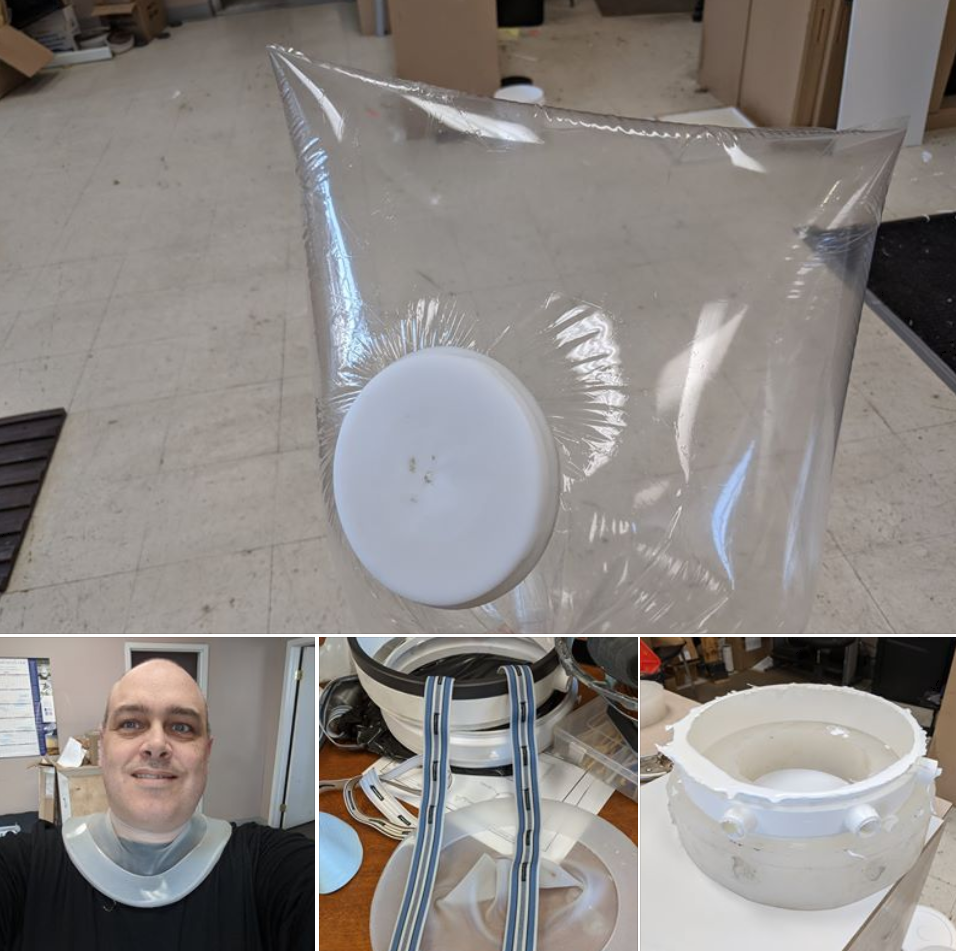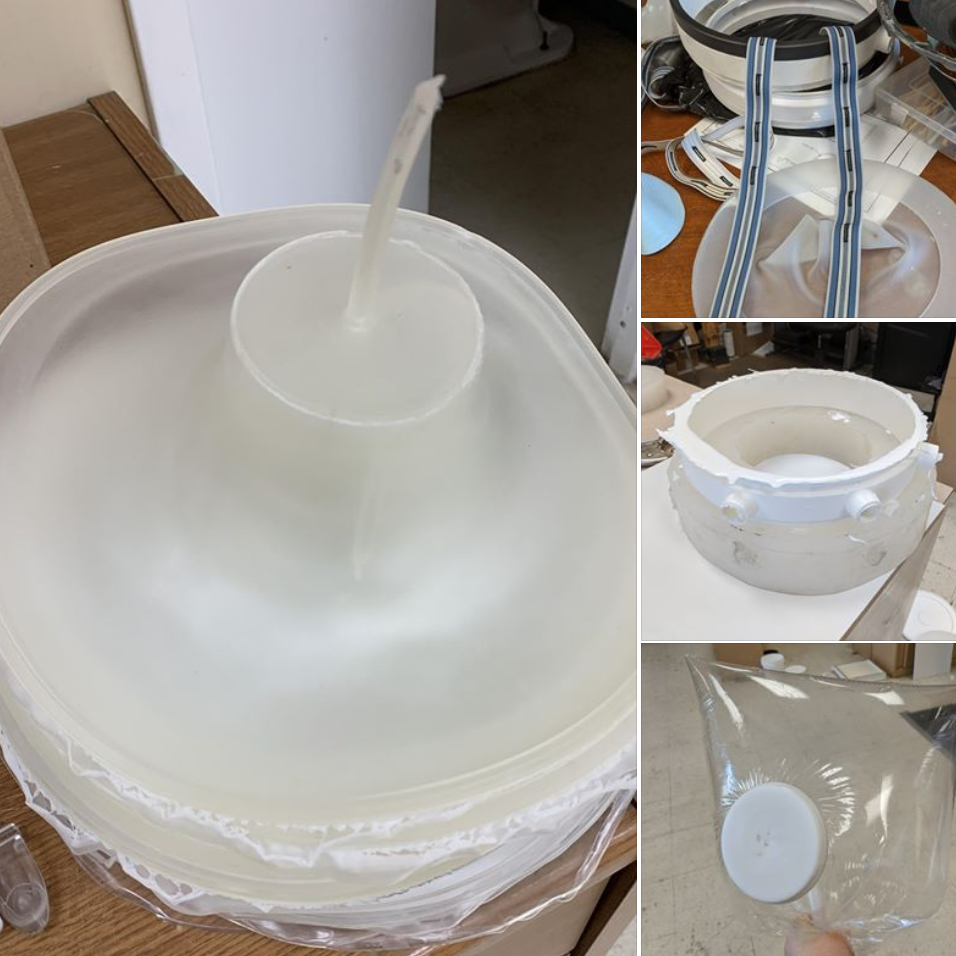Canada getting on board with helmet-based ventilation as worldwide efforts continue to combat COVID
- Aurika Savickaite

- May 9, 2020
- 6 min read
Updated: Jul 22, 2020
5/9/2020 Chicago
COVID-19 is a worldwide pandemic, not choosing who it takes down. And the efforts to combat the virus also is taking worldwide efforts, as physicians, researchers, and manufacturers work together to find remedies.
A Canadian physician is excited to be able to share not only his experiences with helmet-based ventilation systems – but also to be able to share the design with others during the COVID-19 pandemic.

Scott Loree hopes to soon be able to have helmet-based ventilation hoods available for COVID-19 patients in Canada. Loree recently spoke with Aurika Savickaite about the efforts and achievements to manufacture helmets for patients.
Video
Loree is working to tweak designs to get the helmets out as soon as possible. It has been a whirlwind effort, with more successes as non-invasive ventilation is gaining recognition.
“The thrust of my deployment, the thrust of my interest for this, is going to be mostly rural, because we have places that are two, three, four, six hours drive from an ICU,” he said. “You can imagine what would happen with an intubated patient out there.”
Loree has a substantial interest in rural medicines and vast experience in small rural hospitals in Alberta where there often is only one physician in town.
“When COVID started ramping up and we started seeing more and more people needing ICU care, I started to worry about what was going to happen in a lot of these smaller places,” Loree said.
Many of those hospitals lack negative-pressure rooms available, or staff with little experience with intubation.
That inspired Loree to look for a solution – and he found a video from Italy where the helmets were being used.
“That inspired me to go looking as to whether that would be a good solution – why were they using these in the Italian ICUs – maybe they know something we don’t.”
An Internet search led him to manufacturers including Sea-Long, Amron, and Intersurgical (Italy). He quickly realized the companies would be tapped out of their supplies due to universal demand.
“I concluded if we were going to have these things here for us, we would have to build them locally,” he said.
His continued research led him to the HelmetBasedVentilation.com website, which validated the success of the helmets. Loree started searching for plastic manufacturers in Alberta who might be interested in collaborating to develop helmets. He found Tom Vermeeren of Gemma Plastic Products, Inc., in Edmonton which builds a variety of custom pieces for oil fields to plastic bags and lots in-between.
“Tom was quite enthusiastic about it, in fact, he had already ordered 20,000 liters of ethanol to make hand sanitizer and build the bottles for our local health authority,” Loree said. “So, he was already in it up to his waist, so I dragged him in and put him up to his eyeballs.”
The men exchanged ideas, designs, redesigns, and more, settling on a cast polyurethane process for the neck ring. Vermeeren designed a plastic master for the neck ring, thinking they would use a 3-D printer – but that did not work as they hoped, Loree said. The part shrunk 0.5% coming off the printer, causing fitment problems.
“It was frustrating,” Loree said.
For the soft, flexible neck seal, Vermeeren first tried a type of special effects silicone used to build make-up prosthetics – a soft material which sealed very well – but more durability was needed.
Vermeeren brainstormed with one of his machinists, and the two came up with an injection-molding approach, and, using a CNC machine made a mold out of steel – a process that took about 30 hours.
The search is now on to find the best material to injection mold the neck seal -- not too stiff, but durable enough to stretch more than 500% and pull over a patient’s head without discomfort.
It is an ongoing process, Loree said, and he and Vermeeren are hard-set on wanting the product to be successful, Loree said. Manufacturing is challenging, Loree said.
“It’s a matter of making sure this is right,” Loree said regarding the urgency to help patients. “Tere is a sort of a spectrum between it works, and it works good enough and it’s perfect. Not good enough or it barely works is sure to sink the project,” he said.
The goal is to make 200 helmets, Loree said, adding that is a lot “to make on your kitchen table.”
“And then there’s the issue that healthcare workers are not ‘makers’ – they’re not interested in fiddling with it to make it work – if it doesn’t just work and go on and do what it is supposed to, they’re not going to want to use it,” Loree said.
The health authorities are not interested in something that is manufactured on the kitchen table, he added. Canadian hospitals are working cooperatively together to combat COVID-19, determining which hospitals will offer what services – and are not in competition, Loree said.
Loree talked to the Zone Emergency Operations Center in Calgary, where the Head of Procurement expressed interest in the helmet, and suggested they pursue Health Canada approval – which Loree found had a special approval process for emergency COVID-related medical devices.
Loree compiled information he and Vermeeren had, University of Chicago information from the HelmetBasedVentilation.com website, cited the rationale for the helmet use, along with analysis of failure scenarios and how to deal with those and submitted it.
Health Canada responded with questions and requests, including generating a unique code to identify the product. Loree complied and within 10 days, was issued a Health Canada approval. A letter of approval must go out with each hood, Loree said, and they are required to track adverse events.
“My plan is that everyone that uses it should be emailing us back with results – the status of why they used it, and what vitals looked like – a brief case report kind of thing,” he said.
Loree found the information, including studies and videos, on HelmetBasedVentilation.com website very helpful in gaining approval, he said.
“Health Canada employees were all very supportive -- they quickly came to the conclusion it wasn’t dangerous, and our manufacturing plan was responsible and usable,” Loree said. Savickaite pointed out there is a learning curve and emphasized how important it is to follow guidelines.
“Look at the physiology, look at the patient and see what’s happening and then make a decision based on that,” she said.
“I hope very soon we’re going to have a protocol we can publish,” Savickaite said. Loree commended Savickaite for the website HelmetBasedVentilation.com she and her husband David Lukauskas developed.
“The tutorials, and protocols, and information you’ve put on online with the website are extremely helpful,” he said. “Those are basically most of my plans for the instruction manual for this helmet.
“It needs to be written, as well, but to connect them with the information out of the website, it’s important to be able to educate them as an in-service type process, because there is no way we are going to be able to give everyone experience with this before they use it,” Loree said.
Savickaite shared that Loree started a GoFundMe page to help support helmet production for Canada. The helmets will be sent as a kit, with all the parts needed, so no medical facility must seek out parts.
“Keep sharing ideas,” Loree said. “It’s a cooperative effort; it’s not a competition.”
About Scott Loree
Scott Loree is a Family-trained Emergency Physician in Calgary, whose extensive experience in rural hospitals and care inspired him to seek a way to efficiently and successfully manufacture non-invasive helmet-based systems to help patients dealing with COVID-19. He is quite familiar with the use of ventilators from his time as a critical care transport paramedic before medical school, and through his daughter, who has been dependent on a ventilator for much of her life. He holds degrees in Physiology, Psychology and Philosophy, and a Wilderness Medicine Fellowship with experience in Disaster, Diving, and High-Altitude Medicine. He also enjoys making things to help solve problems. Click here to go to Loree’s GoFundMe page.
About Tom Vermeeren
Tom has a background in structural design and plastics manufacturing. This has been very beneficial when designing new products and converting metal parts to plastic products over the last 27 years. Tom has worked in the rubber industry compounding and molding rubber. On the plastic side, he has worked in pultrusion, extrusion, injection molding, and casting of materials. Tom is a graduate of Fanshawe College Civil Engineering Technology program with a major in structural design, and a graduate of the NAIT Plastic Engineering Technology program.
About Aurika Savickaite and David Lukauskas
Aurika Savickaite NP, RN and her husband, David Lukauskas, an entrepreneur, and biohacker, founded and developed the website HelmetBasedVentilation.com to compile and share information about NIV helmet based ventilation during the COVID-19 pandemic.
Aurika Savickaite, NP, RN, MSN, was involved in the successful testing of the helmet ventilator in the ICU at the University of Chicago during a three-year trial study.
While in pursuit of a Master of Science in Nursing – Acute Care Nurse Practitioner degree at Rush University College of Nursing (2014), she wrote her capstone paper, Noninvasive Positive Pressure Ventilation (NIPPV) for Treatment of Acute Respiratory Failure in Immunocompromised Patient, based on her experience with ventilation via the helmet.
Savickaite has worked as a registered nurse and patient care manager at the University of Chicago Medical Center, Medical Intensive Care Unit, and as a staff nurse at Vilnius University Hospital, Santariskiu Clinic, in the intensive care unit. She earned a Bachelor of Rehabilitation and Nursing at Vilnius University Faculty of Medicine in 2001.











Comments